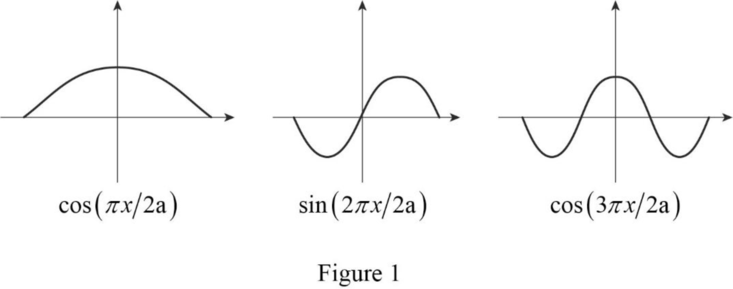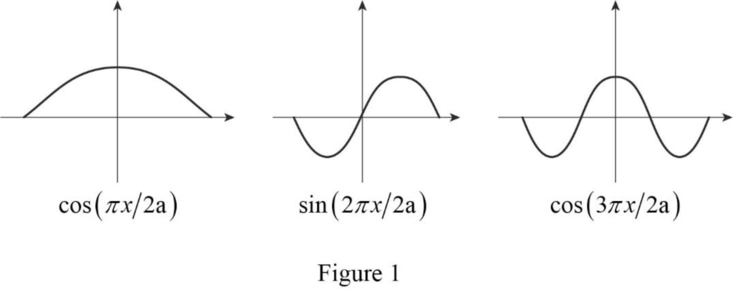
Check the allowed energies of the centered infinite square well are consistent with equation 2.30, and confirm that the wave function can be obtained from the equation 2.31, and sketch the first three solution.
Answer to Problem 2.36P
The allowed energies of the centered infinite square well are consistent with equation 2.30, and the wave function can be obtained from the equation 2.31. The sketch the first three solution is shown below.

Explanation of Solution
Write the solution of classical simple harmonic oscillator.
The time boundary conditions are
Apply this condition in equation1.
Add equation (II) and (III), and solve.
Where j = 1,2,3,…
Subtract equation (II) and (III), and solve.
If
Let
Then the equation (I) becomes,
Normalise the function in the equation (VI).
If
Let
Then the equation (I) becomes,
Normalise the function in the equation (VIII).
In these both cases, the energy will get as follows.
This is in agreement with equation 2.30 for a well of width 2a.
Use
So graph for the above function for first three solution is shown below.

It is same as Figure 2.2, except that some are upside down.
Conclusion:
Therefore, the allowed energies of the centered infinite square well are consistent with equation 2.30, and the wave function can be obtained from the equation 2.31. The sketch the first three solution is shown in Figure 1.
Want to see more full solutions like this?
Chapter 2 Solutions
Introduction To Quantum Mechanics
- The wavefunction of is Ψ(x) = Axe−αx2/2 for with energy E = 3αℏ2/2m. Find the bounding potential V(x). Looking at the potential’s form, can you write down the two energy levels that are immediately above ??arrow_forwardCalculate the expectation value of x2 in the state described by ψ = e -bx, where b is a ħ constant. In this system x ranges from 0 to ∞.arrow_forwardUse perturbation theory to calculate the first-order correction to the ground state energy ofan anharmonic oscillator whose potential energy is given by,arrow_forward
- Derive the Nernst Equation from the definition of the free energy, G.arrow_forwardFor a particle in a box of length L sketch the wavefunction corresponding to the state with the lowest energy and on the same graph sketch the corresponding probability density. Without evaluating any integrals, explain why the expectation value of x is equal to L/2.arrow_forwardFind the wave function and energy for the infinite-walled well problemCould you explain it to me step by step and in detail?Thanks a lotarrow_forward
- The Hamiltonian of a spin in a constant magnetic field B aligned with the y axis is given by H = aSy, where a is a constant. a) Use the energies and eigenstates for this case to determine the time evolution [psi](t) of the state with initial condition [psi](0) = (1/root[2])*mat([1],[1]). b) For your solution from part (a), calculate the expectation values <Sx>, <Sy>, <Sz> as a function of time. Better formatted version of the question is attached.arrow_forwardObtain the value of the Lagrange multiplier for the particle above the bowl given by x^2+y^2=azarrow_forwardFind the Dual of the function below and check if it is self-dual:F4 = (XY + YZ + ZX)arrow_forward
- Please add explanation and check answer properly before submit For a particle subjected to a harmonic oscillator potential, obtain the probability that the particle is outside the classical region, if it is in the ground state.arrow_forwardA function of the form e^−gx2 is a solution of the Schrodinger equation for the harmonic oscillator, provided that g is chosen correctly. In this problem you will find the correct form of g. (a) Start by substituting Ψ = e^−gx2 into the left-hand side of the Schrodinger equation for the harmonic oscillator and evaluating the second derivative. (b) You will find that in general the resulting expression is not of the form constant × Ψ, implying that Ψ is not a solution to the equation. However, by choosing the value of g such that the terms in x^2 cancel one another, a solution is obtained. Find the required form of g and hence the corresponding energy. (c) Confirm that the function so obtained is indeed the ground state of the harmonic oscillator and has the correct energy.arrow_forwardIf you double the width of a one-dimensional infinite potential well, (a) is the energy of the ground state of the trapped electron multiplied by 4, 2, , , or some other number? (b) Are the energies of the higher energy states multiplied by this factor or by some other factor, depending on their quantum number?arrow_forward
 Modern PhysicsPhysicsISBN:9781111794378Author:Raymond A. Serway, Clement J. Moses, Curt A. MoyerPublisher:Cengage Learning
Modern PhysicsPhysicsISBN:9781111794378Author:Raymond A. Serway, Clement J. Moses, Curt A. MoyerPublisher:Cengage Learning Classical Dynamics of Particles and SystemsPhysicsISBN:9780534408961Author:Stephen T. Thornton, Jerry B. MarionPublisher:Cengage Learning
Classical Dynamics of Particles and SystemsPhysicsISBN:9780534408961Author:Stephen T. Thornton, Jerry B. MarionPublisher:Cengage Learning

